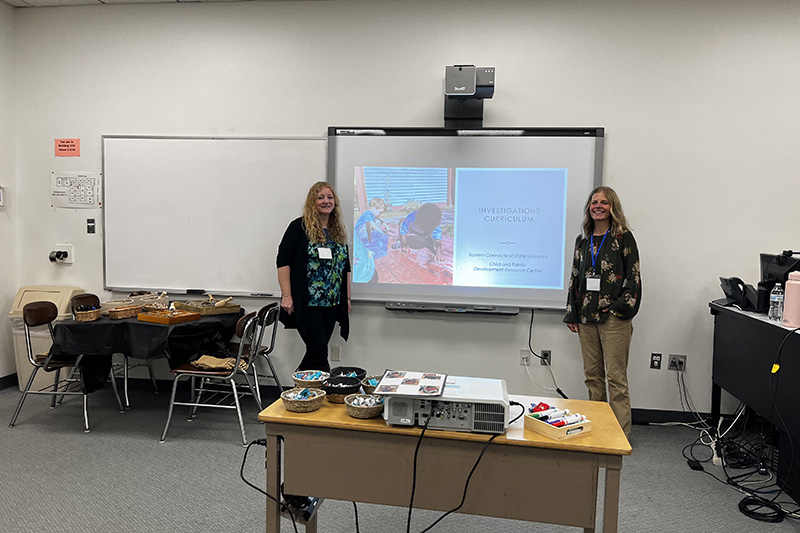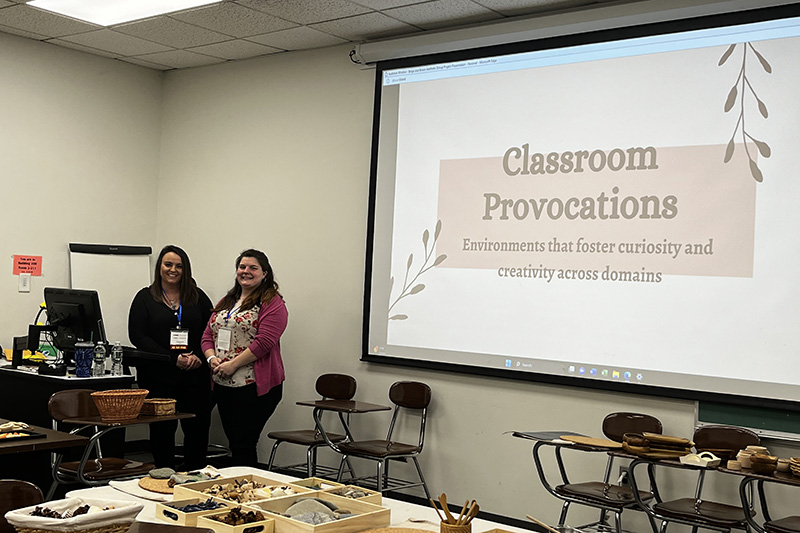- Apply
- Visit
- Request Info
- Give
Teachers from campus preschool present on nurturing curiosity
Written by Elisabeth Craig
Published on November 01, 2023

Five teachers from the Child and Family Development Resource Center (CFDRC) at Eastern Connecticut State University have conducted research on the importance of nurturing a child’s curiosity and creativity. They were selected to represent Eastern at the recent Connecticut Association for the Education of Young Children conference.
The teachers are Patricia McCarthy, Jacqueline Roman, Sabrina Bowersett, Emily Grogan and Corene Charette.
McCarthy, Roman and Bowersett, in their presentation, “Investigations Curriculum: Nurturing Toddler and Preschool Children’s Competency, Curiosity and Capabilities,” focused on the acknowledgment of independent thinking in young children. Their theories are based on the success of the curriculum used the CFDRC, Eastern's on-campus preschool. McCarthy said their mission was to share these results with the conference attendees to influence them to take a similar approach in their classrooms.
“This is a collaboration of three teachers sharing their experiences based on the center’s philosophy that all young children have potential and are competent, curious and capable of asking and answering their own questions, taking intellectual risks and co-constructing knowledge with teachers, families and peers.” McCarthy said.

Emily Grogan and Corene Charette’s presentation, “Preschool Provocations: Environments that Foster Curiosity and Creativity Across Domains,” was a workshop showing teachers how to encourage spirits of inquiry in children by using found and natural objects in their lessons. These natural objects include various thrifted utensils such as baskets and wooden bowls as well as items fresh from outside, such as seashells and leaves. Using provocations allows teachers to examine children’s communication skills and cognitive reasoning and work with them on how to enhance their trains of thought.
“We believe that setting up open-ended materials in an inviting way draws children in to explore, especially in areas where they may not typically choose to engage,” said Charette. “Using provocations helps to enhance and develop meaningful exploration and use of materials.”
Charette and Grogan also explained how the use of materials in lessons can be a social activity for children. The variety of objects presented inspire them to use their imaginations and act out scenarios. Imagination is a crucial component of curiosity, which continues the cycle of asking thoughtful questions.
“In our experience, when materials are presented in this way, as opposed to simply dumping over a bucket or basket of toys on a table, there is not only more engagement, but also longer and more meaningful engagement,” said Charette, “The opportunities for play are boundless when presented in an open-ended and purposeful way.”
Both presentations highlighted the importance of allowing children to formulate their own hypotheses and opinions and teaching them how to articulate their thoughts. This instills cognitive thinking skills in children that they can continue to expand on intuitively as they grow.
“We have a high level of respect for the curriculum that the Child and Family Development Resource Center uses and have had the opportunity to work with it for several years,” said McCarthy, “We decided to apply to the conference to share the curriculum with colleagues in early childhood education.”


